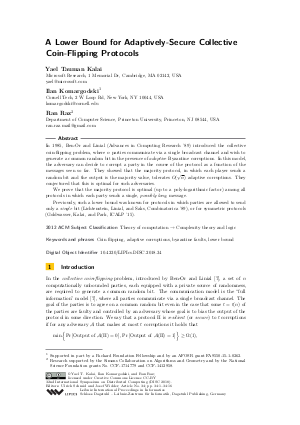A Lower Bound for Adaptively-Secure Collective Coin-Flipping Protocols
Authors Yael Tauman Kalai, Ilan Komargodski, Ran Raz
-
Part of:
Volume:
32nd International Symposium on Distributed Computing (DISC 2018)
Part of: Series: Leibniz International Proceedings in Informatics (LIPIcs)
Part of: Conference: International Symposium on Distributed Computing (DISC) - License:
 Creative Commons Attribution 3.0 Unported license
Creative Commons Attribution 3.0 Unported license
- Publication Date: 2018-10-04
File

PDF
LIPIcs.DISC.2018.34.pdf
- Filesize: 0.5 MB
- 16 pages
Document Identifiers
Subject Classification
ACM Subject Classification
- Theory of computation → Complexity theory and logic
Keywords
- Coin flipping
- adaptive corruptions
- byzantine faults
- lower bound
Metrics
- Access Statistics
-
Total Accesses (updated on a weekly basis)
0Document
0Metadata
Abstract
In 1985, Ben-Or and Linial (Advances in Computing Research '89) introduced the collective coin-flipping problem, where n parties communicate via a single broadcast channel and wish to generate a common random bit in the presence of adaptive Byzantine corruptions. In this model, the adversary can decide to corrupt a party in the course of the protocol as a function of the messages seen so far. They showed that the majority protocol, in which each player sends a random bit and the output is the majority value, tolerates O(sqrt n) adaptive corruptions. They conjectured that this is optimal for such adversaries. We prove that the majority protocol is optimal (up to a poly-logarithmic factor) among all protocols in which each party sends a single, possibly long, message. Previously, such a lower bound was known for protocols in which parties are allowed to send only a single bit (Lichtenstein, Linial, and Saks, Combinatorica '89), or for symmetric protocols (Goldwasser, Kalai, and Park, ICALP '15).
Cite As Get BibTex
Yael Tauman Kalai, Ilan Komargodski, and Ran Raz. A Lower Bound for Adaptively-Secure Collective Coin-Flipping Protocols. In 32nd International Symposium on Distributed Computing (DISC 2018). Leibniz International Proceedings in Informatics (LIPIcs), Volume 121, pp. 34:1-34:16, Schloss Dagstuhl – Leibniz-Zentrum für Informatik (2018)
https://doi.org/10.4230/LIPIcs.DISC.2018.34
BibTex
@InProceedings{taumankalai_et_al:LIPIcs.DISC.2018.34,
author = {Tauman Kalai, Yael and Komargodski, Ilan and Raz, Ran},
title = {{A Lower Bound for Adaptively-Secure Collective Coin-Flipping Protocols}},
booktitle = {32nd International Symposium on Distributed Computing (DISC 2018)},
pages = {34:1--34:16},
series = {Leibniz International Proceedings in Informatics (LIPIcs)},
ISBN = {978-3-95977-092-7},
ISSN = {1868-8969},
year = {2018},
volume = {121},
editor = {Schmid, Ulrich and Widder, Josef},
publisher = {Schloss Dagstuhl -- Leibniz-Zentrum f{\"u}r Informatik},
address = {Dagstuhl, Germany},
URL = {https://drops.dagstuhl.de/entities/document/10.4230/LIPIcs.DISC.2018.34},
URN = {urn:nbn:de:0030-drops-98230},
doi = {10.4230/LIPIcs.DISC.2018.34},
annote = {Keywords: Coin flipping, adaptive corruptions, byzantine faults, lower bound}
}
Author Details
Funding
- Komargodski, Ilan: Supported in part by a Packard Foundation Fellowship and by an AFOSR grant FA9550-15-1-0262.
- Raz, Ran: Research supported by the Simons Collaboration on Algorithms and Geometry and by the National Science Foundation grants No. CCF-1714779 and CCF-1412958.
References
-
Miklós Ajtai and Nathan Linial. The influence of large coalitions. Combinatorica, 13(2):129-145, 1993.

-
Bar Alon and Eran Omri. Almost-optimally fair multiparty coin-tossing with nearly three-quarters malicious. In Theory of Cryptography - 14th International Conference, TCC 2016-B, pages 307-335, 2016.

-
Noga Alon and Moni Naor. Coin-flipping games immune against linear-sized coalitions. SIAM J. Comput., 22(2):403-417, 1993.

-
Noga Alon and Joel Spencer. The Probabilistic Method. John Wiley, third edition, 2008.

-
Amos Beimel, Iftach Haitner, Nikolaos Makriyannis, and Eran Omri. Tighter bounds on multi-party coin flipping, via augmented weak martingales and di erentially private sampling. Electronic Colloquium on Computational Complexity (ECCC), 24:168, 2017.

-
Amos Beimel, Eran Omri, and Ilan Orlov. Protocols for multiparty coin toss with a dishonest majority. J. Cryptology, 28(3):551-600, 2015.

-
Michael Ben-Or and Nathan Linial. Collective coin flipping. Advances in Computing Research, 5:91-115, 1989.

-
Ravi B. Boppana and Babu O. Narayanan. The biased coin problem. SIAM J. Discrete Math., 9(1):29-36, 1996.

-
Niv Buchbinder, Iftach Haitner, Nissan Levi, and Eliad Tsfadia. Fair coin flipping: Tighter analysis and the many-party case. In Proceedings of the Twenty-Eighth Annual ACM-SIAM Symposium on Discrete Algorithms, SODA, pages 2580-2600. SIAM, 2017.

-
Richard Cleve. Limits on the security of coin flips when half the processors are faulty (extended abstract). In Juris Hartmanis, editor, Proceedings of the 18th Annual ACM Symposium on Theory of Computing, pages 364-369. ACM, 1986.

-
Richard Cleve and Russell Impagliazzo. Martingales, collective coin flipping and discrete control processes (extended abstract), 1993. Unpublished manuscript.

-
Yevgeniy Dodis. Impossibility of black-box reduction from non-adaptively to adaptively secure coin-flipping. Electronic Colloquium on Computational Complexity (ECCC), 7(39), 2000.

- Devdatt P. Dubhashi and Alessandro Panconesi. Concentration of Measure for the Analysis of Randomized Algorithms. Cambridge University Press, 2009. URL: http://dx.doi.org/10.1017/CBO9780511581274.
-
Uriel Feige. Noncryptographic selection protocols. In 40th Annual Symposium on Foundations of Computer Science, FOCS, pages 142-153, 1999.

-
Shafi Goldwasser, Yael Tauman Kalai, and Sunoo Park. Adaptively secure coin-flipping, revisited. In 42nd International Colloquium on Automata, Languages and Programming,, ICALP, pages 663-674, 2015.

-
Iftach Haitner and Eliad Tsfadia. An almost-optimally fair three-party coin-flipping protocol. SIAM J. Comput., 46(2):479-542, 2017.

-
Jeff Kahn, Gil Kalai, and Nathan Linial. The influence of variables on boolean functions (extended abstract). In 29th Annual Symposium on Foundations of Computer Science, FOCS, pages 68-80, 1988.

-
Yael Tauman Kalai and Ilan Komargodski. Compressing communication in distributed protocols. In Distributed Computing - 29th International Symposium, DISC, pages 467-479, 2015.

-
David Lichtenstein, Nathan Linial, and Michael E. Saks. Some extremal problems arising form discrete control processes. Combinatorica, 9(3):269-287, 1989.

-
Tal Moran, Moni Naor, and Gil Segev. An optimally fair coin toss. J. Cryptology, 29(3):491-513, 2016.

-
Alexander Russell, Michael E. Saks, and David Zuckerman. Lower bounds for leader election and collective coin-flipping in the perfect information model. SIAM J. Comput., 31(6):1645-1662, 2002.

-
Michael E. Saks. A robust noncryptographic protocol for collective coin flipping. SIAM J. Discrete Math., 2(2):240-244, 1989.

